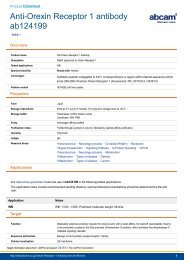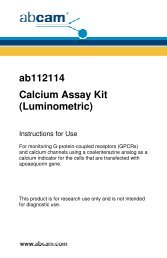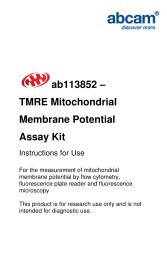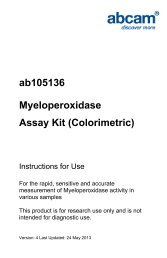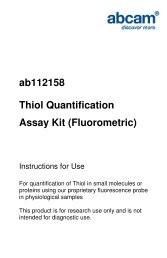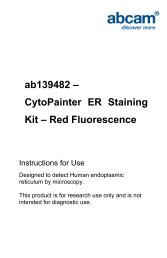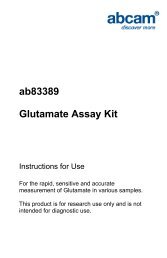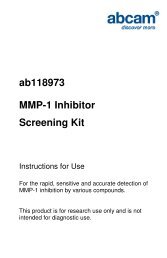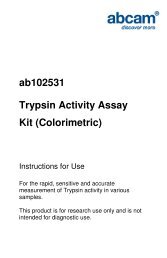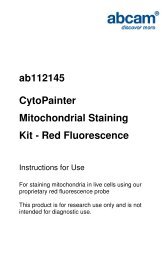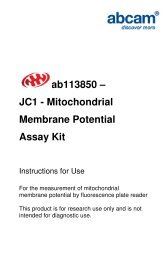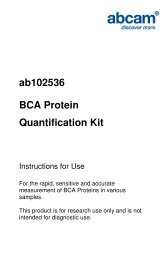ab83371 Alkaline Phosphatase Assay Kit (Fluorometric) - Abcam
ab83371 Alkaline Phosphatase Assay Kit (Fluorometric) - Abcam
ab83371 Alkaline Phosphatase Assay Kit (Fluorometric) - Abcam
You also want an ePaper? Increase the reach of your titles
YUMPU automatically turns print PDFs into web optimized ePapers that Google loves.
<strong>ab83371</strong><br />
<strong>Alkaline</strong> <strong>Phosphatase</strong><br />
<strong>Assay</strong> <strong>Kit</strong> (<strong>Fluorometric</strong>)<br />
Instructions for Use<br />
For the rapid, sensitive and accurate<br />
measurement of <strong>Alkaline</strong> <strong>Phosphatase</strong> in various<br />
samples.<br />
This product is for research use only and is not<br />
intended for diagnostic use.
<strong>ab83371</strong> <strong>Alkaline</strong> <strong>Phosphatase</strong> <strong>Assay</strong> <strong>Kit</strong> (<strong>Fluorometric</strong>)<br />
1
<strong>ab83371</strong> <strong>Alkaline</strong> <strong>Phosphatase</strong> <strong>Assay</strong> <strong>Kit</strong> (<strong>Fluorometric</strong>)<br />
Table of Contents<br />
1. Overview 3<br />
2. Protocol Summary 4<br />
3. Components and Storage 5<br />
4. <strong>Assay</strong> Protocol 7<br />
5. Data Analysis 9<br />
6. Troubleshooting 11<br />
2
<strong>ab83371</strong> <strong>Alkaline</strong> <strong>Phosphatase</strong> <strong>Assay</strong> <strong>Kit</strong> (<strong>Fluorometric</strong>)<br />
1. Overview<br />
<strong>Alkaline</strong> <strong>Phosphatase</strong> (ALP) catalyzes the hydrolysis of phosphate<br />
esters in alkaline buffer and produces an organic radical and<br />
inorganic phosphate. The change in alkaline phosphatase level and<br />
activity is associated with a lot of diseases in the liver and bones.<br />
<strong>Alkaline</strong> phosphatase is also a popular enzyme conjugated to<br />
secondary antibody in ELISA.<br />
<strong>Abcam</strong>’s <strong>Alkaline</strong> <strong>Phosphatase</strong> <strong>Assay</strong> <strong>Kit</strong> (<strong>Fluorometric</strong>), ALP<br />
cleaves the phosphate group of the non-fluorescent 4-<br />
Methylumbelliferyl phosphate disodium salt (MUP) substrate<br />
resulting in an intense fluorescent signal (Ex/Em = 360nm/440nm).<br />
The kit is an ultra sensitive, simple, direct and HTS-ready assay<br />
designed to measure ALP activity in serum and bio-samples with<br />
detection sensitivity ~1 µU, more sensitive than colorimetric assays.<br />
3
<strong>ab83371</strong> <strong>Alkaline</strong> <strong>Phosphatase</strong> <strong>Assay</strong> <strong>Kit</strong> (<strong>Fluorometric</strong>)<br />
2. Protocol Summary<br />
Sample Preparation<br />
Add MUP Substrate Solution<br />
Standard Curve Preparation<br />
Add ALP Enzyme Solution<br />
A<br />
Add Stop Solution<br />
Measure Fluorescence<br />
4
<strong>ab83371</strong> <strong>Alkaline</strong> <strong>Phosphatase</strong> <strong>Assay</strong> <strong>Kit</strong> (<strong>Fluorometric</strong>)<br />
3. Components and Storage<br />
A. <strong>Kit</strong> Components<br />
Item<br />
Quantity<br />
ALP <strong>Assay</strong> Buffer<br />
100 mL<br />
MUP Substrate<br />
1 vial<br />
ALP Enzyme<br />
1 vial<br />
Stop Solution<br />
25 mL<br />
* Store the kit at -20°C, protect from light.<br />
• Allow <strong>Assay</strong> Buffer to warm to room temperature before<br />
use.<br />
• Briefly centrifuge vials prior to opening.<br />
• Keep samples and ALP Solution on ice during the assay.<br />
• Read the entire protocol before performing the assay.<br />
MUP SOLUTION: Dissolve MUP substrate into 1.2 ml <strong>Assay</strong> Buffer<br />
to generate 5 mM MUP substrate solution. The MUP solution is<br />
stable for 2 month at -20°C after dissolved.<br />
5
<strong>ab83371</strong> <strong>Alkaline</strong> <strong>Phosphatase</strong> <strong>Assay</strong> <strong>Kit</strong> (<strong>Fluorometric</strong>)<br />
ALP ENZYME SOLUTION: Reconstitute ALP Enzyme with 1 ml<br />
<strong>Assay</strong> Buffer. The reconstituted enzyme is stable for up to 2 months<br />
at 4°C. DO NOT FREEZE!<br />
B. Additional Materials Required<br />
• Microcentrifuge<br />
• Pipettes and pipette tips<br />
• Fluorescent microplate reader<br />
• 96 well plate<br />
• Orbital shaker<br />
6
<strong>ab83371</strong> <strong>Alkaline</strong> <strong>Phosphatase</strong> <strong>Assay</strong> <strong>Kit</strong> (<strong>Fluorometric</strong>)<br />
4. <strong>Assay</strong> Protocol<br />
1. Sample Preparation:<br />
Note: Inhibitors of ALP, like tartrate, fluoride, EDTA, oxalate, and<br />
citrate, should be avoided in sample preparation.<br />
a. Serum, plasma, urine, semen, and cell culture media can be<br />
assayed directly.<br />
b. Cells (1×10 5 ) or tissue (~10 mg): Homogenize in 100 µl <strong>Assay</strong><br />
Buffer, centrifuge to remove insoluble material at 13,000 x g for<br />
3 minutes.<br />
Add test samples directly into 96-well plate, bring total volume to<br />
110 µl with <strong>Assay</strong> Buffer.<br />
In order to avoid interference of components in the sample, set a<br />
sample background control. Add the same amount of samples<br />
into separate wells, bring volume to 110 µl. Add 20 µl Stop<br />
Solution and mix well to terminate ALP activity in the sample.<br />
2. Dilute enough 5 mM MUP substrate solution to 0.5 mM with <strong>Assay</strong><br />
Buffer (1:10); add 20 µl of the 0.5 mM MUP substrate solutions to<br />
each well containing the test samples and background controls. Mix<br />
well. Incubate the reaction for 30 min (or longer if ALP activity in<br />
sample is low) at 25°C, protect from light.<br />
7
<strong>ab83371</strong> <strong>Alkaline</strong> <strong>Phosphatase</strong> <strong>Assay</strong> <strong>Kit</strong> (<strong>Fluorometric</strong>)<br />
3. Standard Curve Preparation:<br />
Dilute 10 µl of the 5 mM MUP solution with 990 µl <strong>Assay</strong> Buffer to<br />
generate 50 µM MUP standards. Add 0, 2, 4, 6, 8, 10 µl into 96-well<br />
plate in duplicate to generate 0, 0.1, 0.2, 0.3, 0.4, 0.5 nmol/well MUP<br />
standard. Bring the final volume to 120 µl with <strong>Assay</strong> Buffer.<br />
Add 10 µl of ALP enzyme solution to each well containing the MUP<br />
standard. Mix well. Incubate the reaction for 30 min at 25°C, protect<br />
from light. The ALP enzyme will convert MUP substrate to equal<br />
amount of fluorescent 4-Methylumbelliferone (4-MU).<br />
4. Stop all reactions by adding 20 µl Stop Solution into each<br />
standard and sample reaction except the sample background control<br />
reaction (since 20 µl Stop Solution has been added into the<br />
background control when prepare the sample background control in<br />
step 1), gently shake the plate.<br />
5. Measure fluorescence intensity at Ex/Em 360/440 nm using a<br />
fluorescence microtiter plate reader.<br />
8
<strong>ab83371</strong> <strong>Alkaline</strong> <strong>Phosphatase</strong> <strong>Assay</strong> <strong>Kit</strong> (<strong>Fluorometric</strong>)<br />
5. Data Analysis<br />
Correct background by subtracting the value derived from the<br />
sample background controls for samples.<br />
Plot the 4-MU standard Curve. Apply sample readings to the<br />
standard curve to get the amount of 4-MU generated by ALP<br />
sample.<br />
ALP activity of the test samples can be calculated:<br />
ALP activity= A / V/ T (mU/ml)<br />
Where:<br />
A is amount of 4-MU generated by samples (in nmol).<br />
V is volume of sample added in the assay well (in ml).<br />
T is reaction time (in minutes).<br />
Unit Definition: The amount of enzyme causing the hydrolysis of<br />
1 µmol of MUP per minute at pH 10.0 and 25°C (glycine buffer).<br />
9
<strong>ab83371</strong> <strong>Alkaline</strong> <strong>Phosphatase</strong> <strong>Assay</strong> <strong>Kit</strong> (<strong>Fluorometric</strong>)<br />
ALP 4-MU Standard Curve: Performed according to assay protocol.<br />
10
<strong>ab83371</strong> <strong>Alkaline</strong> <strong>Phosphatase</strong> <strong>Assay</strong> <strong>Kit</strong> (<strong>Fluorometric</strong>)<br />
6. Troubleshooting<br />
Problem Reason Solution<br />
<strong>Assay</strong> not<br />
working<br />
Unexpected<br />
results<br />
<strong>Assay</strong> buffer at<br />
wrong temperature<br />
Protocol step missed<br />
Plate read at<br />
incorrect wavelength<br />
Unsuitable microtiter<br />
plate for assay<br />
Measured at wrong<br />
wavelength<br />
Samples contain<br />
impeding substances<br />
Unsuitable sample<br />
type<br />
Sample readings are<br />
outside linear range<br />
<strong>Assay</strong> buffer must not be chilled<br />
- needs to be at RT<br />
Re-read and follow the protocol<br />
exactly<br />
Ensure you are using<br />
appropriate reader and filter<br />
settings (refer to datasheet)<br />
Fluorescence: Black plates<br />
(clear bottoms);<br />
Luminescence: White plates;<br />
Colorimetry: Clear plates.<br />
If critical, datasheet will indicate<br />
whether to use flat- or U-shaped<br />
wells<br />
Use appropriate reader and filter<br />
settings described in datasheet<br />
Troubleshoot and also consider<br />
deproteinizing samples<br />
Use recommended samples<br />
types as listed on the datasheet<br />
Concentrate/ dilute samples to<br />
be in linear range<br />
11
<strong>ab83371</strong> <strong>Alkaline</strong> <strong>Phosphatase</strong> <strong>Assay</strong> <strong>Kit</strong> (<strong>Fluorometric</strong>)<br />
Samples<br />
with<br />
inconsistent<br />
readings<br />
Lower/<br />
Higher<br />
readings in<br />
samples<br />
and<br />
standards<br />
Unsuitable sample<br />
type<br />
Samples prepared in<br />
the wrong buffer<br />
Samples not<br />
deproteinized (if<br />
indicated on<br />
datasheet)<br />
Cell/ tissue samples<br />
not sufficiently<br />
homogenized<br />
Too many freezethaw<br />
cycles<br />
Samples contain<br />
impeding substances<br />
Samples are too old<br />
or incorrectly stored<br />
Not fully thawed kit<br />
components<br />
Out-of-date kit or<br />
incorrectly stored<br />
reagents<br />
Reagents sitting for<br />
extended periods on<br />
ice<br />
Incorrect incubation<br />
time/ temperature<br />
Incorrect amounts<br />
used<br />
Refer to datasheet for details<br />
about incompatible samples<br />
Use the assay buffer provided<br />
(or refer to datasheet for<br />
instructions)<br />
Use the 10kDa spin column<br />
(ab93349)<br />
Increase sonication time/<br />
number of strokes with the<br />
Dounce homogenizer<br />
Aliquot samples to reduce the<br />
number of freeze-thaw cycles<br />
Troubleshoot and also consider<br />
deproteinizing samples<br />
Use freshly made samples and<br />
store at recommended<br />
temperature until use<br />
Wait for components to thaw<br />
completely and gently mix prior<br />
use<br />
Always check expiry date and<br />
store kit components as<br />
recommended on the datasheet<br />
Try to prepare a fresh reaction<br />
mix prior to each use<br />
Refer to datasheet for<br />
recommended incubation time<br />
and/ or temperature<br />
Check pipette is calibrated<br />
correctly (always use smallest<br />
volume pipette that can pipette<br />
entire volume)<br />
12
<strong>ab83371</strong> <strong>Alkaline</strong> <strong>Phosphatase</strong> <strong>Assay</strong> <strong>Kit</strong> (<strong>Fluorometric</strong>)<br />
Problem Reason Solution<br />
Standard<br />
curve is not<br />
linear<br />
Not fully thawed kit<br />
components<br />
Pipetting errors when<br />
setting up the<br />
standard curve<br />
Incorrect pipetting<br />
when preparing the<br />
reaction mix<br />
Air bubbles in wells<br />
Concentration of<br />
standard stock<br />
incorrect<br />
Errors in standard<br />
curve calculations<br />
Use of other<br />
reagents than those<br />
provided with the kit<br />
Wait for components to thaw<br />
completely and gently mix prior<br />
use<br />
Try not to pipette too small<br />
volumes<br />
Always prepare a master mix<br />
Air bubbles will interfere with<br />
readings; try to avoid producing<br />
air bubbles and always remove<br />
bubbles prior to reading plates<br />
Recheck datasheet for<br />
recommended concentrations of<br />
standard stocks<br />
Refer to datasheet and re-check<br />
the calculations<br />
Use fresh components from the<br />
same kit<br />
For further technical questions please do not hesitate to<br />
contact us by email (technical@abcam.com) or phone (select<br />
“contact us” on www.abcam.com for the phone number for<br />
your region).<br />
13
<strong>ab83371</strong> <strong>Alkaline</strong> <strong>Phosphatase</strong> <strong>Assay</strong> <strong>Kit</strong> (<strong>Fluorometric</strong>)<br />
14
UK, EU and ROW<br />
Email: technical@abcam.com<br />
Tel: +44 (0)1223 696000<br />
www.abcam.com<br />
US, Canada and Latin America<br />
Email: us.technical@abcam.com<br />
Tel: 888-77-ABCAM (22226)<br />
www.abcam.com<br />
China and Asia Pacific<br />
Email: hk.technical@abcam.com<br />
Tel: 108008523689 ( 中 國 聯 通 )<br />
www.abcam.cn<br />
Japan<br />
Email: technical@abcam.co.jp<br />
Tel: +81-(0)3-6231-0940<br />
www.abcam.co.jp<br />
Copyright © 2012 <strong>Abcam</strong>, All Rights Reserved. The <strong>Abcam</strong> logo is a registered trademark.<br />
All information / detail is correct at time of going to print.



